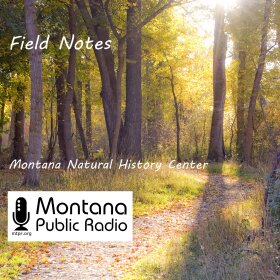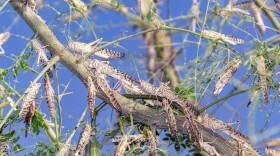
Field Notes
Wed. at 3:53 p.m., Sat. at 11:53 a.m.
Nature notes and inquiry from the Montana Natural History Center.
-
This Montana prairie holds a secret. This is coulee country, a landscape peppered with gullies waiting to be explored.
-
A visitor to the Yellowstone National Park helped with a calf struggling to cross a river. After, the calf began approaching people and cars, hazardous for all concerned.
-
Wind has a way of blowing in and cutting short an adventure. It can ruin a picnic. It can wreak havoc on the best-laid plans. At its worst, it can be dangerous and even deadly. But it also creates the breeze that shakes the leaves of quaking aspen. It carries the seeds of black cottonwood and the wings of Red-tailed Hawks to new destinations.
-
Most plants conduct photosynthesis and make their own food from sunlight, carbon dioxide and water. Fungus flowers, however, cannot conduct photosynthesis, making them not only look bizarre but function in a bizarre manner.
-
Tyrell’s tufted, along with most jumping spider species, is not aggressive. Jumping spiders actively hunt their food using their speed, the hunters of the arachnid world.
-
We continue walking, giving the shoreline a wide berth to avoid scaring any loons that might be around. Now we're on the opposite side of the lake and—we see them. Two adult Common Loons. Oh, they're lovely: streamlined, low-slung bodies, perfect for diving. Sleek black heads, red eyes, and characteristic black-and-white coloration that makes it easy to identify them.
-
It’s June and I’m in a dreamy meadow deep in the backcountry of Mount Rainier National Park, looking for toads. My mission: find the toads, count the toads, save the toads—in that order.
-
Crawdads have specialized cells in their exoskeletons that allow them to change color to adapt to their surroundings. The cells, called chromatophores, work to either concentrate or disperse pigment. Similar cells in chameleons and octopuses allow for a quick color change. But, for crawdads, the process is slower.
-
Northern Harriers are considered one of the most elusive raptors, and some of the most accomplished wildlife photographers admit how difficult they are to photograph. Male Harriers, with their white underside and opaque gray-back plumage, seem to be even more challenging to photograph than the brown and much larger females. For that reason, many birders and photographers call male Harriers “Gray Ghosts.”. One moment they’re in your viewfinder, the next, they’re gone.
-
I was delighted to observe such an unusual visitor, but he had a bigger surprise for me. As I watched him forage through my yard he did something unique I had never seen, heard of, nor even imagined!
-
Tufted evening primrose is one of the loveliest native plants found in dry climates across western and central North America. Its botanical name translates to “wine seeker, densely clumped,” which is apt for a low-growing, mounded plant with very fragrant, citrus-scented flowers.
-
I could not articulate what pulled me off the trail, but I followed the urge all the way to the base of the towering tree, a western redcedar. I stood, neck bent back to take in its shading canopy of soft, scaly leaves. We greeted one another in an exchange that predates my ancestors taking human form: the mammalian exhale of carbon dioxide and inhale of oxygen from the trees.
-
As a teenage boy on the farm in Iowa, I experienced a horde of grasshoppers while unloading a wagon of oats. The surface was covered with grasshoppers! It was not difficult to grab one, and when I did, it would “spit tobacco.” I have since learned that spitting a dark liquid is a defense mechanism. Memories like this one have stuck with me, and in part fueled my interest in the mass of grasshoppers that somehow ended up in Rocky Mountain glaciers.
-
You’ve probably seen it before, even if you didn’t know exactly what you were looking at: some black, woody growth on cherry or plum trees. Black knot fungus, or Apiosporina morbosa, is a fungal agent that invades young trees of the Prunus genus, including most hard-pitted, fruit-bearing trees like cherries, plums, apricots, and peaches.
-
For seven years, I pursued the jay-sized birds on Rattlesnake Creek in Missoula, Montana. That quest to observe a nesting pair turned out to be challenging. Belted kingfishers are loners, skittish, and fiendish to study. However, the rewards of a difficult journey are many—like finding something never recorded before.
-
Straightening the quilt on one of the cots, I glimpsed movement through a window and rushed - barefoot - to the narrow deck to see what it was: a herd of 200 elk galloping along each rise and dip of the valley below the treehouse.
-
Spending time in nature with its wild creatures has always been a way for me to rejuvenate my creativity, to fill my soul with happiness, tranquility, and relaxation. A way to let go of stress and worries, even for just a little bit. Recently I wondered how I could give back to the wildlife that makes itself at home around our five acres, to help it co-exist and thrive. Wanting to keep this little ecosystem as natural as possible, I came across the web page of the National Wildlife Federation’s Garden For Wildlife.
-
Mountain goats, which aren’t actually goats but are considered “goat-antelopes” and whose closest relatives live in the Himalayas, prefer to live above the treeline and in high alpine meadows, beyond the usual range of predators like mountain lions. Beyond the range of many humans, too. They are one of the least-studied large mammals in North America.
-
I was ahead of my husband when I spotted a bear standing in clear view, close by on the gentle slope that led away from the trail. I stopped and smiled as my brain tried to make sense of why the bear was so short and broad…and why were its legs and back darker than its tawny sides? My jaw dropped when the synapses connected. It wasn’t a bear. It was a wolverine!
-
One June about seven years ago, my husband brought home a bitterroot plant. It was stuck to his irrigation shovel by the clay soil from the hay fields near our house in the Helmville Valley. I marveled at the beautiful hot pink blooms and planted them in the flower bed, where they rarely reappeared.
-
Early in April, I had just spied a fox squirrel eating pine seeds from a ground cache when I felt a shadow gliding overhead on silent wings. I looked up yet saw nothing. When I looked back, there was an indistinct gray form, an apparition, in the shadows where the squirrel had been. The apparition turned its head toward me and peered with two large golden eyes. Tufted horns now held erect confirmed it was a Great Horned Owl.
-
What do tree swallows, starlings, pigeons, hummingbirds, and mallard ducks all have in common? Besides being birds, of course, each of these species sports iridescent feathers that glimmer and shine when the light hits them.






















